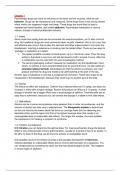Summary
Comprehensive summary of psychopharmacology literature 2023/2024
- Course
- Institution
- Book
Last year, I completed the psychopharmacology course with a 9.5! I then made an extensive summary of the book in detail and it will be used again this year.
[Show more]




